Regular readers who follow this site, who in particular have a keen eye on what’s cooking in the world of Panasonic, would have undoubtedly read our verdict on the company’s top-end WT65/WT60 series of LED LCD TVs. Here for review now we have the TX-L32E6B, which is the second-to-smallest display in the Japanese manufacturer’s Smart Viera television lineup.
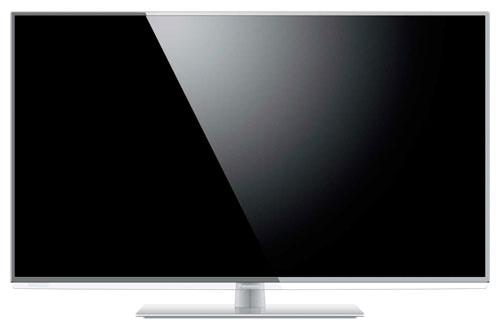
The Panasonic TX-L32E6 lacks many of the features of its flagship counterpart, but does have LED edge-lighting, a full white balance and colour management system (CMS), and Smart Viera access. This includes a personalised Home screen option, integrated WiFi, and various apps including BBC iPlayer, Netflix and You Tube.
So, with all the attention seemingly devoted to the “smart” elements of modern-day HDTVs, has the most important feature – picture quality – been neglected? Let’s take a closer look.
On unpacking this review sample, we were instantly drawn to the striking visual appearance of the Panasonic E6. The screen is encased in a plastic bezel with a brushed metallic silver finish, which is less than a centimetre thick. As eye-catching as the bezel is, our favourite visual aspect of the TV is the transparent strip running along the bottom displaying the Panasonic logo to maximum effect. Attaching the panel to the matching silver base was a breeze, but we were slightly disappointed to find it wouldn’t allow you to swivel or tilt the screen. Other than the non-swivel issue, this is a beautiful-looking display that looks far more expensive than its current £399 price tag.
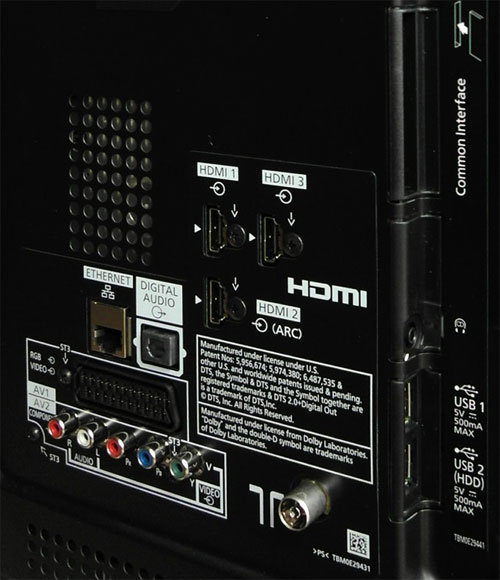 |
| 3x HDMI, 2x USB, component, RGB Scart, Freeview HD tuner, ethernet & audio outs |
When firing up the TXL32E6B you’re instantly welcomed by the Smart Viera Interface which we’ll go into more detail later on in the review. Panasonic’s user menu is really nicely laid out, and easy to navigate. There’s very little lag between choosing various options, which makes navigating through the interface a joy. One feature we really like is that as soon as a picture or sound (or any setting for that matter) option is highlighted, there is a small, one-line description at the bottom explaining what that control does in relation to the television. It’s a small feature but a very useful one. In terms of viewing modes there are five options: “Dynamic“, “Normal“, “Cinema“, “True Cinema” and “Custom“. Why manufacturers choose to include picture settings like “Dynamic” and “Normal” is beyond us, as they couldn’t be more inaccurate when it comes to greyscale calibration. Under intense lighting conditions like store showrooms, these settings can sometimes help, but for home viewing stay well away!
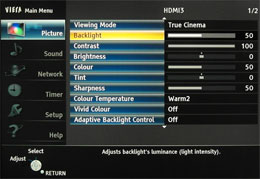 | 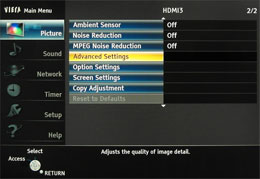 |
| [Picture] menu |
Scrolling through the picture settings we come to the [Advanced Settings] submenu, and we’re pleased to report that Panasonic has included not only a 2-point white balance control, but also a full 10p option. Things get better still with a colour management system (CMS) which allows independent control to hue, saturation, and luminance for the red, green and blue primary colours. Gamma doesn’t get overlooked and also receives a full 10p control system. Video enthusiasts will be jumping for joy that Panasonic has chosen to include these advanced options on a TV at this price point, and we in turn also take our calibrating hats off to the company!
![[Advanced Settings] submenu](https://www.hdtvtest.co.uk/news/wp-content/uploads/2018/04/hdtv_Panasonic-TXL32E6_advanced.jpg) | ![[Option Settings] submenu](https://www.hdtvtest.co.uk/news/wp-content/uploads/2018/04/hdtv_Panasonic-TXL32E6_option.jpg) |
| [Advanced Settings] submenu | [Option Settings] submenu |
There’s an [Option Settings] tab which unlocks some other advanced options, including a film cadence mode which when enabled improves vertical resolution for movie images. This is important when dealing with standard-definition film content to help achieve cadence lock. There’s also a [1080p Pixel Direct] option which must be switched on for full 4:4:4 reproduction. Another important setting is found in the [Screen Settings] submenu, namely [16:9 Overscan] which must be switched off to display the 1080p image in its original size.
The Panasonic TX-L32E6B comes with one remote control. There’s nothing really special about it, but the rubber buttons are clearly labelled, and it’s easy to navigate.
For the first measurement, we selected the [True Cinema] mode which should be the most accurate out-of-the-box setting, so let’s see how we got on.
The results for an out-of-the-box reading were very good with an average dE of 2.47. The default colour tone in [True Cinema] is “Warm 2“, which produced a greyscale with excessive red at the higher scale, and blue dips between 10-30 and 30-70. With the vast array of calibration controls at our disposal, this should be an easy fix.
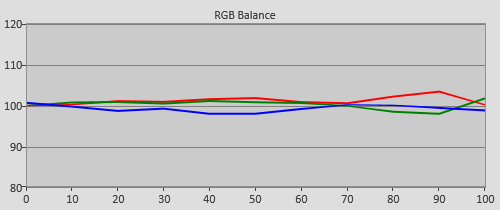 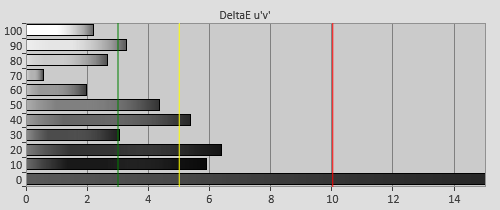 |
| Pre-calibration RGB tracking and delta errors (dEs) |
Results after calibration were sublime to say the least, with an average dE of 0.62, and all 10-100 measurements under 3 where any errors were academic and unnoticeable to the human eye. Before any greyscale readings were taken, there were a few settings that needed to be adjusted in the [True Cinema] mode. The first was [Contrast], which was set full at “100“, producing a reading of 170 cd/m2 which was far too bright and caused clipping issues. Using the 100% full-field pattern and our light measurement meter, we tweaked the contrast to the correct setting, but the display was still too bright. A few clicks down on the [Backlight] solved this issue, and we hit our target of 120 cd/m2.
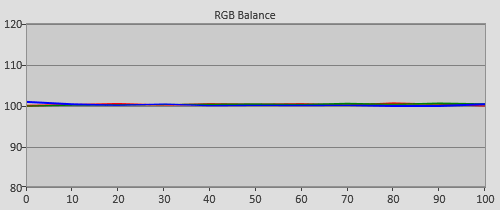 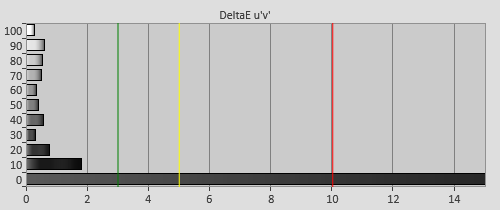 |
| Post-calibration RGB tracking and dEs in [True Cinema] mode |
To get the result above we took full advantage of the TXL32E6B’s 10p white balance controls. The two-point option got us almost there, but we did have to tweak the 10 and 20 readings to get them below a dE of 3. This did however make errors higher at the 40 and 50 readings, so we ended up making further tweaks higher up the scale to rectify this and bring overall errors down as low as possible. The results were then excellent.
The overall gamma control in [True Cinema] tracked at 2.21 rather than our reference target of 2.4 which has now been classed as reference by the ITU for flat screen HD displays, for viewing and mastering in a dark environment.
![Pre-calibrated gamma tracking in [True Cinema] mode](https://www.hdtvtest.co.uk/news/wp-content/uploads/2018/04/hdtv_Panasonic-TXL32E6_pre-gamma.png) | ![Post-calibrated gamma tracking in [True Cinema] mode](https://www.hdtvtest.co.uk/news/wp-content/uploads/2018/04/hdtv_Panasonic-TXL32E6_post-gamma.png) |
| Pre-calibration gamma tracking (2.21) | Post-calibration gamma tracking (2.33) |
The default gamma setting in out-of-the-box [True Cinema] was set at “2.2“, so we changed that to “2.4” which actually gave us a gamma of 2.33. The Panasonic has a 10p gamma gain control, but we found that trying to raise the gamma at the higher scale also affected the greyscale. This resulted in higher dE errors as a tradeoff, so we chose to leave the gamma alone at 2.33.
Colours were again very good out of the box in [True Cinema] mode, with only marginal errors in colour decoding. After calibration however, the highly accurate greyscale we achieved helped the Panasonic’s colour decoding become practically perfect. Errors across the saturation tracking points were again improved with all points falling again under the dE 3 threshold. We found that accessing the colour management system to try to improve the saturation sweeps would have a negative effect on the way the TX-L32E6 was decoding the colours, so we left the saturation sweeps where they were. By negative we mean the decoding was still good, just not as on the money as before.
![Post-calibration Colour saturation tracking in [True Cinema] mode](https://www.hdtvtest.co.uk/news/wp-content/uploads/2018/04/hdtv_Panasonic-TXL32E6_post-strack.jpg) |
| Post-calibration colour saturation tracking |
![Post-calibration colour errors in [True Cinema] mode](https://www.hdtvtest.co.uk/news/wp-content/uploads/2018/04/hdtv_Panasonic-TXL32E6_post-strack-de.png) |
| Post-calibration colour errors (<3 not appreciable to the eye) |
| Dead pixels | None |
| Screen uniformity | Some light pooling issues observed |
| Overscanning on HDMI | 0% with [16:9 Overscan] set to “Off“ |
| Blacker than black | Passed |
| Calibrated black level (black screen) | Edge LEDs dim to 0.023 cd/m2 |
| Calibrated black level (ANSI checkerboard) | 0.134 cd/m2 |
| Black level retention | Auto-dimming with full black screen |
| Primary chromaticity | Good |
| Scaling | Excellent |
| Video mode deinterlacing | Effective jaggies reduction |
| Film mode deinterlacing | Passed 3:2 over 480i & 1080i; and 2:2 over 576i |
| Viewing angle | Good for LCD |
| Motion resolution | 250-300 |
| Digital noise reduction | Defeatable |
| Sharpness | Defeatable edge enhancement |
| Luma/Chroma bandwidth (2D Blu-ray) | Full luma & full chroma with [1080p Pixel Direct] on |
| 1080p/24 capability | No judder |
| Input lag (Leo Bodnar tester) | 26ms |
| Default [Normal] mode | 50 watts |
| Calibrated [True Cinema] mode | 36 watts |
| Standby | <1 watt |
One of the first questions that prospective buyers want answered with any flat-screen HDTV is how good the black-level performance is. As important as black level is in the overall assessment of any display, it’s in dimly-lit rooms in particular where it can make or break the display. Our initial black level reading was 0.023 cd/m2, which would be remarkable for an LCD TV, but it was soon apparent that the auto-dimming trick had struck again. With the pause button enabled to stop the auto-dimming kicking in, we measured a black level reading of 0.134 cd/m2 on both a full-field black and ANSI checkerboard screen. This means that the Panasonic TXL32E6B has marginally deeper blacks than its flagship brother the TX-L55WT65. Let’s not get too excited though, as the TX-L55WT65B’s blacks were not too impressive to say the least, but it’s remarkable that a television at this price is exhibiting deeper blacks than another model from the same manufacturer which is over four times the price! It can’t however outmatch the blacks of its other sibling – the TX-L42E6B – whose blacks reached a truly impressive reading of 0.0268 cd/m2 thanks to the use of VA-type LCD panel used on that display. With a reading of 0.134 cd/m2 it looks like Panasonic has chosen to grace the TX-L32E6B with an IPS panel, which means the 32-incher can’t match the black levels of its 42in brother, and that is a real shame.
Daytime viewing really isn’t a problem, but as soon as content is displayed in a dimly-lit or darkened room the problems are apparent. Blacks are by no means grey, but they do have a washed-out look to them that gets worse as you move off-axis. Looking closer whilst displaying a full black image, more limitations are revealed in the consistency of the backlight. In our review sample there were light pooling issues, in particular a significant patch towards the bottom centre of the screen. There is an [Adaptive Backlight Control], but on the TX-L32E6 you can only set it to “On” or “Off“. Engaging the control did give us a marginal improvement in the black level without robbing too much detail, so we decided to leave it on.
That being said, when watching real content, the Viera TX-L32E6B is a great performer as long as there is some ambient light present. Now fully calibrated with an accurate greyscale, the Panasonic offers up an excellent standard-definition picture with accurate colours and enough detail in the image to make for a pleasing watch. Film-based material is handled very well, and the Panasonic has no trouble locking on to 2.2 cadence as long as the film cadence setting is enabled. Panasonic’s scaling and handling of SD images has been very impressive, and the TXL32E6B is no exception.
Freeview HD images are crisp and vibrant, with fine detail rendered extremely well. BBC1’s high-definition feed of The Apprentice looks particularly impressive on the Panasonic E6.
Switching over to Blu-ray and 24p content we move up a gear, several in fact. Panasonic have really nailed their colour palette, and the TX-L32E6 is no exception. Colours are bold and vibrant, and detail is sky high. Native 24p playback on the Panasonic is excellent with no sign of judder, and is true to the original source with no edge enhancement or smoothing of any kind. The opening chase scene of Casino Royale looks particularly impressive, with the 32E6 rendering the sun-kissed, fast-paced action in remarkable detail.
As excellent as the picture is, motion is a shortcoming on the TX-L32E6B. Even with the 100Hz Back Light Blinking, blurring is noticeable on fast panning shots and is untreatable as there are no on-board motion controls.
Panasonic have put a lot of emphasis on the Smart TV elements of the new Viera range. The Smart interface is very appealing, allowing you to create your own homescreen with various apps and features to suit your individual tastes. Creating a homepage is simple to do with the help of templates and on-screen prompts, and as with the main menu interface, the Smart screen interface is nicely laid out, and it’s smooth and speedy to boot.
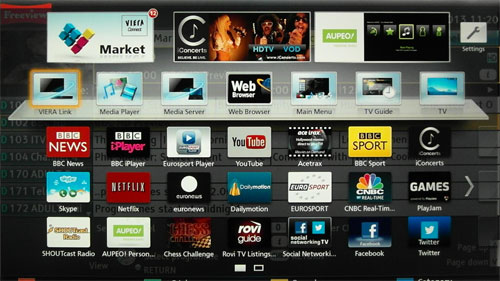
There are a good selection of apps on offer, and the only really disappointment is the lack of catch-up channels. Samsung have trumped Panasonic here by being the only smart television brand offering all the catch-up services, but there are still plenty of other great content on offer which we’re sure will keep everyone happy.
We tried out the YouTube app, and were very impressed with the playback quality. We watched the trailer for the blockbuster film Man Of Steel in HD, and it looked wonderful, taking again full advantage of Panasonic’s excellent grasp of colours and detail.
Using the Leo Bodnar input lag tester, we took readings across all the picture presets available to us. As there is no game mode on the Panasonic TXL32E6B, the lowest reading we got was 24.7ms with the HDTV in its brightest [Dynamic] mode. However, this may be too garish even for playing video games; fortunately the Viera E6 returned similarly impressive figures in the [Normal] (25.7ms), [Cinema] (25.6ms) and [True Cinema] (25.9ms) modes too. These are excellent results, making the TX-L32E6 a very good choice for avid gamers.
The TX-L32E6B’s sound is a bit of a mixed bag. For normal TV broadcast material it’s perfectly acceptable, but it stumbles when it comes to film content. There’s little in the way of dynamics or impact to the soundstage, and what we’re left with is a thin sound severely lacking in low-end response. Increasing the bass to compensate this has a negative impact on the speakers, making them distort, and the overall sound becomes muddy.
For the price, the Panasonic TX-L32E6B is excellent value for money: it not only looks stylish, but also has impressive calibration controls, great Smart features, and good picture quality. Nevertheless there is that last hurdle it just can’t get over, and that is its black level. It’s a real shame that the IPS panel has been chosen for this screen size, as we believe that if a VA LCD panel had been used, this would have been another triumph for the Panasonic LED line-up.
If you’re not concerned about black-level performance, and watch most of your content in the day or in a brightly-lit room, you’ll love the 32E6. However, if you can stretch both the size and budget that little bit more, the better option would be the TX-L42E6B.
